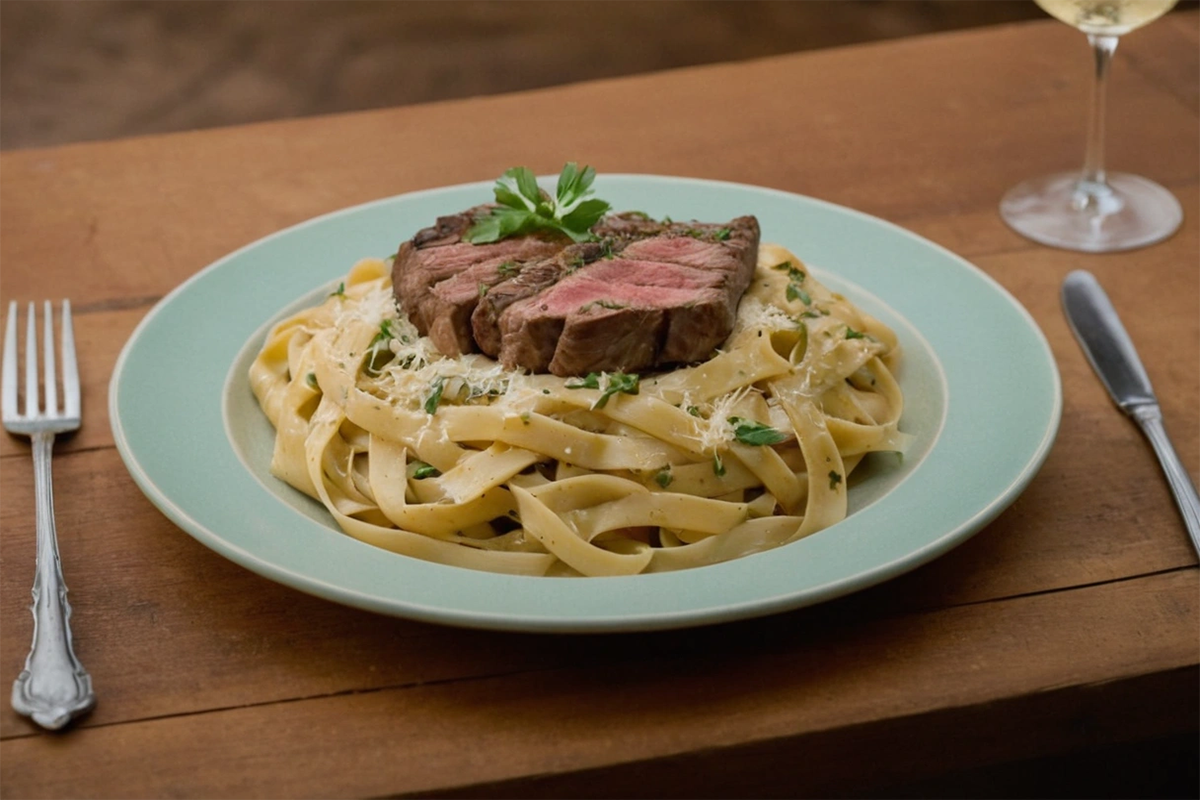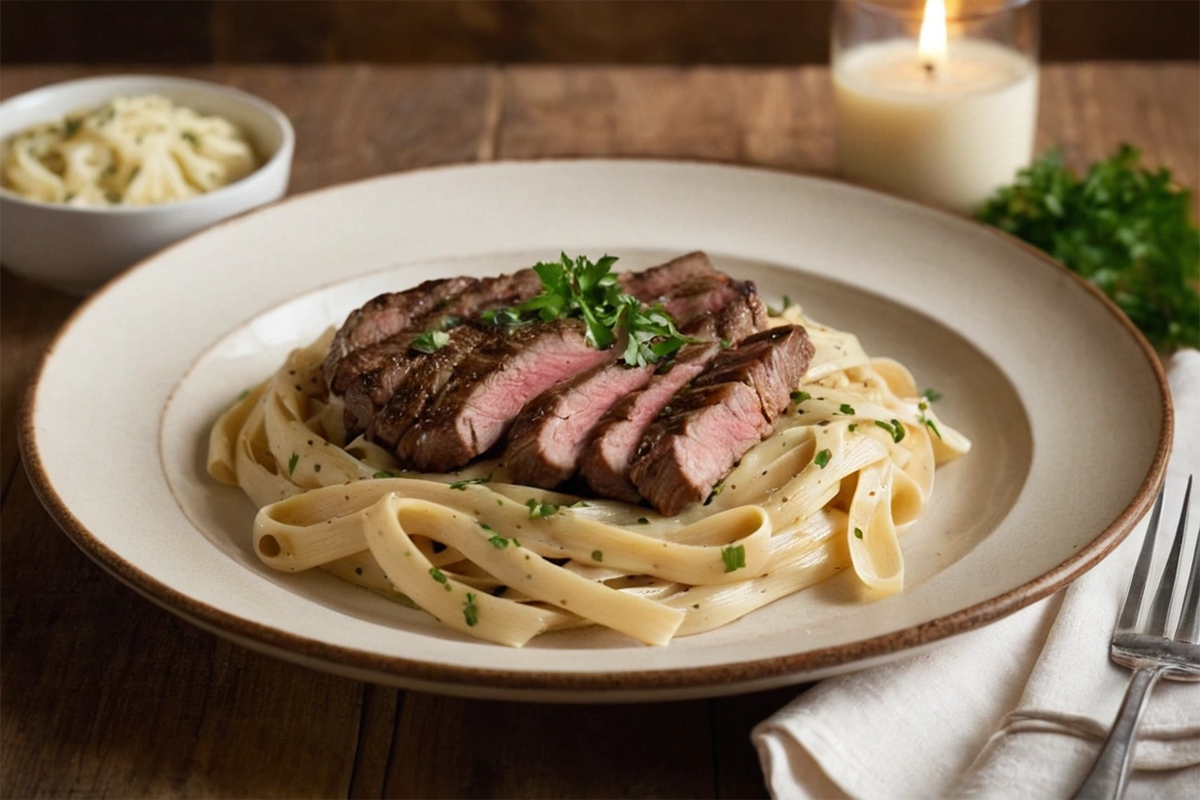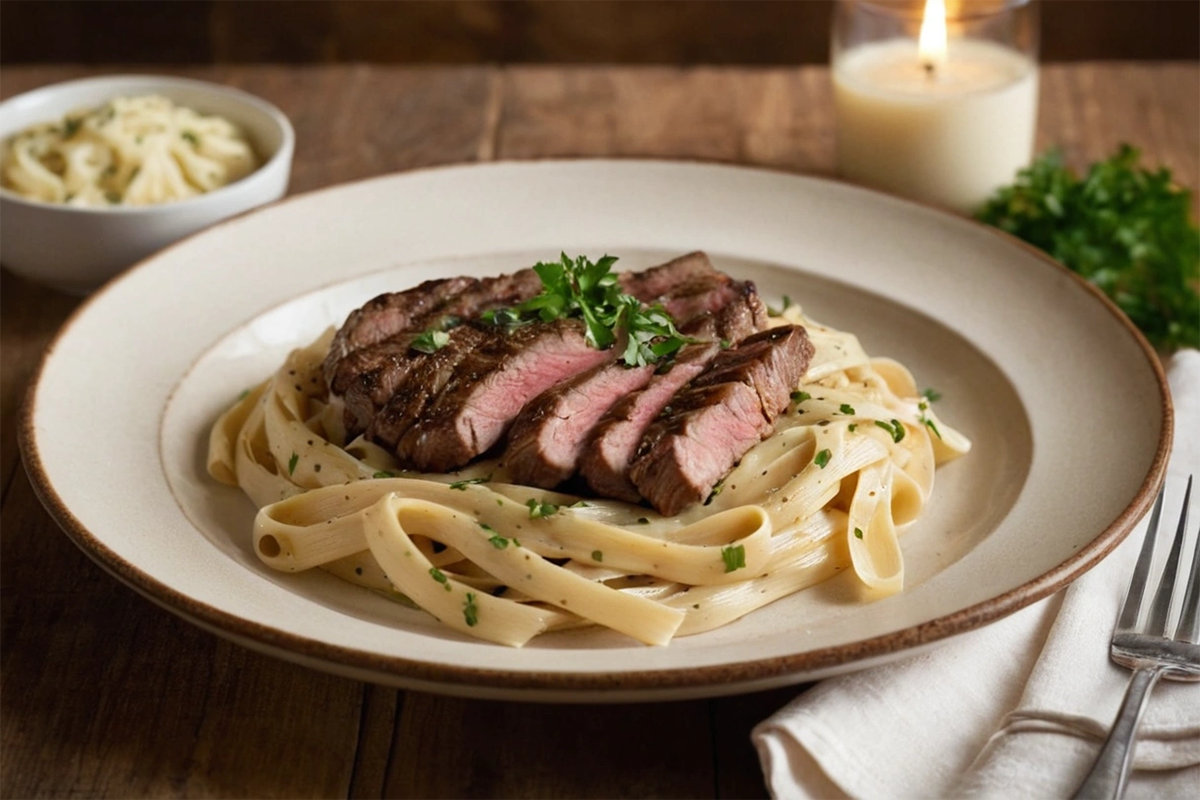Introduction to Steak Pasta
Steak Pasta is the perfect dish for those who crave the richness of a well-cooked steak paired with the comforting heartiness of pasta. This recipe is a fusion of flavors that brings together the tenderness of steak with the satisfying texture of pasta, all enveloped in a rich, flavorful sauce. Whether you’re cooking for a special occasion or just looking for a fulfilling dinner option, steak pasta is sure to impress.
This dish is highly versatile, allowing you to experiment with various cuts of steak, types of pasta, and sauces to suit your taste. It’s no wonder that steak pasta has become a favorite for both home cooks and professional chefs alike. If you’re looking to explore more Italian-inspired dishes, explore more Italian pasta recipes. Additionally, perfecting the steak for this dish is crucial, so here are some tips for cooking steak to perfection.
Table of Contents
History and Origin of Steak Pasta
Origins of Steak Dishes
Steak has long been a staple in many cuisines around the world, known for its rich, savory flavor and versatility in preparation. From the grill to the pan, steak has been enjoyed in countless forms, often serving as the centerpiece of a meal. The tradition of cooking steak to perfection has roots in cultures that prioritize high-quality cuts of meat and meticulous cooking techniques, ensuring that each bite is tender and full of flavor.
Introduction of Pasta in Western Cuisine
Pasta, on the other hand, has its origins in Italy, where it was developed as a staple food that could be easily stored, cooked, and combined with a variety of ingredients. Over the centuries, pasta made its way into Western cuisine, becoming a beloved dish in many households. The versatility of pasta, with its ability to absorb flavors and serve as a base for a wide range of sauces, makes it a natural partner for steak.
Fusion of Steak and Pasta
The combination of steak and pasta is a relatively modern invention, likely emerging from the fusion of Italian and American culinary traditions. As pasta dishes gained popularity in the United States, chefs began experimenting with incorporating traditional American ingredients like steak into classic pasta recipes. The result is a dish that combines the best of both worlds—a hearty, satisfying meal that’s as comforting as it is delicious.
Ingredients for Steak Pasta
Creating a delicious Steak Pasta starts with selecting the right ingredients. Here’s what you’ll need to make this dish truly shine:
Choosing the Right Cut of Steak
The steak is the star of this dish, so it’s important to choose the right cut. Sirloin, ribeye, and filet mignon are all excellent options. These cuts are tender, flavorful, and cook well when seared and sliced thin. Sirloin offers a balance of flavor and tenderness, ribeye is known for its rich marbling, and filet mignon provides a melt-in-your-mouth texture.
Types of Pasta
When it comes to pasta, you have several options. Fettuccine, penne, and pappardelle are popular choices for steak pasta. Fettuccine and pappardelle are wide, flat noodles that hold up well to rich, creamy sauces, while penne offers a more textured bite that works well with tomato-based sauces or garlic butter. Choose the pasta that best complements your sauce and steak.
Sauce Options
The sauce you choose will define the overall flavor of your steak pasta. A creamy Alfredo sauce pairs beautifully with steak, adding a rich, luxurious texture to the dish. Garlic butter sauce, made with fresh garlic, butter, and a splash of lemon juice, offers a lighter option that enhances the natural flavors of the steak. Tomato-based sauces, with their acidity and sweetness, can also work well, especially if you prefer a more traditional Italian flavor profile.
Aromatics and Seasonings
Aromatics like garlic, onions, and herbs are essential for building depth of flavor in your steak pasta. Garlic and onions can be sautéed until soft and golden, adding a savory base to your sauce. Fresh herbs like parsley, thyme, or rosemary bring a burst of freshness, while spices such as black pepper, red pepper flakes, and smoked paprika add warmth and complexity.
Optional Add-ins
To add more texture and nutrition to your steak pasta, consider incorporating vegetables like spinach, mushrooms, or cherry tomatoes. Spinach adds a leafy green element that balances the richness of the steak and sauce, while mushrooms contribute an earthy flavor that complements the meat. Cherry tomatoes provide a pop of sweetness and acidity, brightening the dish and adding color.

Step-by-Step Instructions for Making Steak Pasta
Making Steak Pasta is straightforward, but each step is crucial to achieving a dish that’s full of flavor and perfectly cooked. Here’s how to do it:
Step 1: Preparing the Steak
Start by seasoning your steak generously with salt, pepper, and any other desired spices. Allow the steak to sit at room temperature for about 30 minutes before cooking. This helps ensure an even cook.
Heat a large skillet over medium-high heat and add a tablespoon of olive oil. Once the oil is hot, add the steak to the pan. Sear the steak on each side for about 3-4 minutes, depending on thickness, until a crust forms. For medium-rare, aim for an internal temperature of 130°F (54°C). Once cooked to your liking, remove the steak from the pan and let it rest for at least 5 minutes before slicing it thinly against the grain.
Step 2: Cooking the Pasta
While the steak is resting, bring a large pot of salted water to a boil. Add your pasta and cook according to the package instructions until al dente. It’s important not to overcook the pasta, as it will continue to cook slightly when mixed with the sauce later. Before draining, reserve about 1 cup of pasta water—this will be useful for adjusting the consistency of the sauce.
Step 3: Making the Sauce
In the same skillet used to cook the steak, add a bit more olive oil if needed and sauté finely chopped garlic and onions until they are soft and fragrant. If you’re making a creamy sauce, add heavy cream or half-and-half to the pan, along with a handful of grated Parmesan cheese. Stir until the cheese is melted and the sauce is smooth. For a lighter option, use garlic butter by melting butter in the pan and adding a splash of lemon juice and some pasta water to create an emulsion.
For tomato-based sauces, add crushed tomatoes, a pinch of sugar, and a splash of balsamic vinegar to the sautéed onions and garlic. Let the sauce simmer for about 10 minutes, allowing the flavors to meld together. Season with salt, pepper, and fresh herbs to taste.
Step 4: Combining Steak, Pasta, and Sauce
Once the sauce is ready, add the cooked pasta to the skillet and toss it in the sauce until well coated. If the sauce is too thick, add a bit of the reserved pasta water to thin it out to your desired consistency.
Next, add the sliced steak to the skillet and gently toss everything together. The goal is to ensure that the steak is evenly distributed throughout the pasta and that each bite is coated with the sauce. If you’re adding any vegetables, now is the time to fold them in as well.
Step 5: Final Touches and Serving
Before serving, taste the pasta and adjust the seasoning if necessary. Garnish with freshly grated Parmesan, chopped parsley, or a drizzle of extra virgin olive oil for added flavor and presentation. Serve the steak pasta immediately, while it’s hot and the flavors are at their peak.
Substitutions and Variations
One of the beauties of Steak Pasta is its adaptability. Here are some variations and substitutions you can try:
Steak Alternatives
If you’re looking for a different protein or want to make the dish lighter, consider using chicken, shrimp, or tofu in place of steak. Grilled chicken breast or shrimp adds a different flavor profile but still pairs well with pasta. For a vegetarian option, tofu marinated in soy sauce and garlic can be a delicious alternative.
Pasta Variations
While fettuccine, penne, and pappardelle are traditional choices, you can experiment with other pasta types. Gluten-free pasta made from rice or quinoa is a good option for those with dietary restrictions. Zucchini noodles (zoodles) offer a low-carb alternative that pairs well with steak and rich sauces.
Sauce Adjustments
The sauce can be customized to suit your taste. For a creamier dish, add more heavy cream or even a dollop of mascarpone cheese. If you prefer a tangy kick, increase the amount of lemon juice or balsamic vinegar in the sauce. For those who love spice, a pinch of red pepper flakes or a dash of hot sauce can add heat to the dish.
Vegetable Additions
Incorporating vegetables into your steak pasta not only adds nutrients but also enhances the overall flavor and texture. Roasted peppers, asparagus, or sautéed zucchini are excellent choices. For a more robust dish, add roasted mushrooms or caramelized onions, which bring a depth of flavor that complements the steak.
Health Considerations and Nutritional Information
While Steak Pasta is undeniably delicious, it’s important to consider its nutritional content:
Caloric Content
The calorie count for steak pasta can vary widely depending on the ingredients used. A typical serving ranges from 600 to 800 calories, with most of the calories coming from the steak, pasta, and sauce. To lower the calorie count, consider using a leaner cut of steak, reducing the amount of pasta, or substituting cream with a lower-fat alternative like Greek yogurt.
Protein and Fiber
Steak is an excellent source of protein, which is essential for muscle repair and overall health. Adding vegetables like spinach or zucchini increases the fiber content, which aids digestion and helps you feel full longer. For a high-protein, high-fiber meal, you can also choose a whole wheat or legume-based pasta.
Healthier Alternatives
To make Steak Pasta healthier, there are several adjustments you can make. Using a leaner cut of steak, such as sirloin or tenderloin, reduces the fat content. Substituting heavy cream with a mixture of Greek yogurt and milk can lower the calorie count while still providing a creamy texture. Additionally, incorporating more vegetables and using whole grain or gluten-free pasta can enhance the nutritional value of the dish.
Serving Suggestions and Pairings
Steak Pasta is a versatile dish that can be served on its own or paired with a variety of sides and beverages:
As a Main Dish
Steak pasta is hearty enough to be served as a standalone meal. Its rich flavors and satisfying textures make it perfect for dinner, whether you’re dining alone or hosting a dinner party. Serve it in large bowls to showcase the beautiful combination of steak and pasta, garnished with fresh herbs and a sprinkle of Parmesan cheese.
Side Dishes
To balance the richness of steak pasta, consider serving it with lighter side dishes. A simple green salad with a vinaigrette dressing provides a refreshing contrast to the creamy or savory pasta. Garlic bread is a classic accompaniment that complements the dish, adding a crunchy texture and a burst of garlic flavor. Steamed or roasted vegetables, such as broccoli, green beans, or asparagus, also pair well with steak pasta, adding color and nutrients to the meal.
Beverage Pairings
When it comes to beverages, Steak Pasta pairs beautifully with a variety of drinks. A full-bodied red wine, such as Cabernet Sauvignon or Merlot, complements the richness of the steak and sauce. For a non-alcoholic option, iced tea or sparkling water with a slice of lemon provides a refreshing balance to the meal. If you prefer something more indulgent, a creamy milkshake or a cold glass of beer can be a satisfying accompaniment.
Storing and Reheating Tips
If you have leftovers or want to prepare the dish ahead of time, here’s how to store and reheat Steak Pasta:
Storing Leftovers
Store any leftover steak pasta in an airtight container in the refrigerator. The dish will stay fresh for up to 3 days. To prevent the pasta from becoming soggy, it’s best to store the steak, pasta, and sauce separately if possible.
Reheating
To reheat, place the pasta in a skillet over medium heat. Add a splash of the reserved pasta water or a little broth to help loosen the sauce and prevent the dish from drying out. Stir frequently until the dish is heated through, and be careful not to overcook the steak, as it can become tough.
Freezing
Steak pasta can also be frozen for up to 2 months. To freeze, let the dish cool completely, then transfer it to a freezer-safe container. When you’re ready to eat, thaw the dish in the refrigerator overnight and reheat it in a skillet, adding a little water or broth as needed to revive the sauce.

FAQs About Steak Pasta
What cut of steak is best for steak pasta?
Sirloin, ribeye, and filet mignon are all excellent choices for steak pasta. Sirloin offers a balance of flavor and tenderness, ribeye is known for its rich marbling, and filet mignon provides a melt-in-your-mouth texture.
Can I use different types of pasta?
Yes, you can use a variety of pasta types in steak pasta. Fettuccine, penne, and pappardelle are popular choices, but you can also try gluten-free pasta or vegetable noodles like zucchini noodles (zoodles) for a lighter option.
Is steak pasta healthy?
Steak pasta can be a healthy dish if prepared with lean cuts of steak and plenty of vegetables. To make it healthier, use whole grain or gluten-free pasta, substitute cream with Greek yogurt, and incorporate more vegetables into the dish.
How do I make the steak tender?
To achieve tender steak, season it well and allow it to come to room temperature before cooking. Sear the steak over high heat to form a crust, then cook it to your desired doneness. Let the steak rest for a few minutes before slicing it thinly against the grain to ensure tenderness.
Can I prepare this dish ahead of time?
Yes, you can prepare steak pasta ahead of time by cooking the steak and sauce in advance and storing them separately. Cook the pasta just before serving and combine it with the pre-cooked steak and sauce. This method ensures that the pasta stays fresh and doesn’t become soggy.
Conclusion
Steak Pasta is a decadent, flavorful dish that brings together the best of both worlds—the rich, savory taste of steak and the comforting heartiness of pasta. Whether you’re preparing it for a special occasion or a weeknight dinner, this dish is sure to impress with its versatility and deliciousness.
Experiment with different cuts of steak, types of pasta, and sauces to create a version that’s uniquely yours. With its rich flavors, satisfying textures, and endless possibilities for customization, Steak Pasta is a dish that you’ll want to make again and again.

Steak Pasta
Equipment
- Large Skillet
- Pot
- Mixing Bowl
Ingredients
Steak
- 1 pound Sirloin Steak Or ribeye or filet mignon
Pasta
- 8 ounces Fettuccine Or penne or pappardelle
Sauce
- 1 cup Heavy Cream For creamy sauce
- 1/2 cup Parmesan Cheese Grated
Aromatics
- 3 cloves Garlic Minced
- 1 medium Onion Chopped
Seasonings
- 1 teaspoon Salt
- 1 teaspoon Black Pepper
- 1 tablespoon Olive Oil For cooking
Optional Add-ins
- 1 cup Spinach Fresh
- 1 cup Mushrooms Sliced
Instructions
- Step 1: Season the steak with salt and pepper. Let it sit at room temperature for 30 minutes. Heat olive oil in a skillet over medium-high heat and sear the steak for 3-4 minutes on each side. Remove and let rest.
- Step 2: Cook the pasta in salted boiling water according to package instructions until al dente. Reserve 1 cup of pasta water before draining.
- Step 3: In the same skillet, sauté garlic and onion until soft. Add heavy cream and Parmesan, stirring until smooth.
- Step 4: Combine the cooked pasta with the sauce, adding reserved pasta water as needed. Stir in sliced steak and any optional vegetables.
- Step 5: Adjust seasoning and serve garnished with extra Parmesan and fresh herbs.
